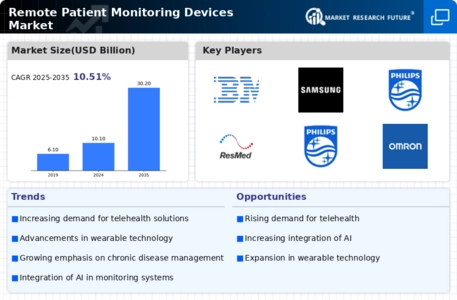Supportive Regulatory Frameworks
Supportive regulatory frameworks are crucial for the growth of the Remote Patient Monitoring Devices Market. Governments and regulatory bodies are increasingly recognizing the importance of remote monitoring in enhancing patient care and reducing healthcare costs. Initiatives aimed at standardizing remote monitoring devices and ensuring their safety and efficacy are being implemented. For instance, regulatory approvals for new monitoring technologies are being expedited, facilitating quicker market entry. This supportive environment encourages innovation and investment in remote monitoring solutions, as manufacturers seek to comply with evolving regulations. As a result, the market is poised for growth, driven by a favorable regulatory landscape that promotes the adoption of remote patient monitoring devices.
Rising Prevalence of Chronic Diseases
The increasing prevalence of chronic diseases such as diabetes, hypertension, and cardiovascular disorders is a primary driver of the Remote Patient Monitoring Devices Market. As healthcare systems strive to manage these conditions effectively, the demand for remote monitoring solutions has surged. According to recent data, chronic diseases account for approximately 70% of all deaths worldwide, necessitating innovative approaches to patient care. Remote patient monitoring devices facilitate continuous health tracking, enabling timely interventions and reducing hospital readmissions. This trend is likely to continue, as healthcare providers increasingly recognize the value of these devices in managing chronic conditions, thereby propelling the market forward.
Growing Focus on Preventive Healthcare
The shift towards preventive healthcare is significantly influencing the Remote Patient Monitoring Devices Market. As healthcare systems aim to reduce costs and improve patient outcomes, there is an increasing emphasis on early detection and management of health issues. Remote monitoring devices enable healthcare providers to identify potential health risks before they escalate into serious conditions. This proactive approach is supported by data indicating that preventive care can reduce healthcare costs by up to 30%. Consequently, the demand for remote patient monitoring solutions is expected to rise, as both patients and providers recognize the benefits of early intervention and continuous health monitoring.
Technological Innovations in Healthcare
Technological advancements play a pivotal role in shaping the Remote Patient Monitoring Devices Market. Innovations such as wearable devices, mobile health applications, and telehealth platforms have transformed how patients interact with healthcare providers. The integration of artificial intelligence and machine learning into monitoring devices enhances data analysis and predictive capabilities, allowing for personalized patient care. Market data indicates that the wearable health technology segment is expected to witness substantial growth, with projections suggesting a compound annual growth rate of over 20% in the coming years. These technological innovations not only improve patient outcomes but also drive the adoption of remote monitoring solutions across various healthcare settings.
Increased Adoption of Telehealth Services
The adoption of telehealth services has been a transformative factor for the Remote Patient Monitoring Devices Market. As healthcare providers expand their telehealth offerings, the integration of remote monitoring devices becomes essential for effective patient management. Data suggests that telehealth usage has increased significantly, with many patients preferring virtual consultations over traditional in-person visits. This trend is likely to continue, as telehealth provides convenience and accessibility, particularly for patients in remote areas. The synergy between telehealth and remote monitoring devices enhances patient engagement and adherence to treatment plans, thereby driving market growth and expanding the reach of healthcare services.


















Leave a Comment